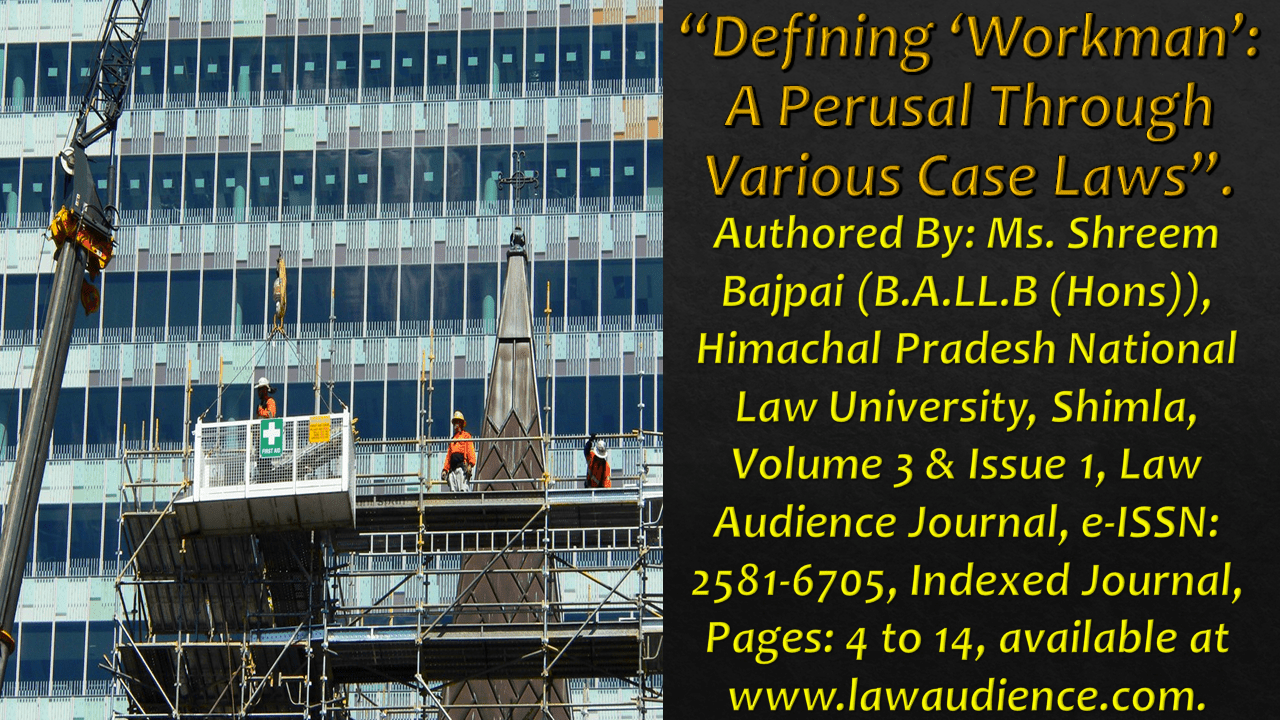Click here to download the full paper (PDF)
Authored By: Ms. Shreem Bajpai (B.A.LL.B (Hons)), Himachal Pradesh National Law University, Shimla,
Click here for Copyright Policy.
ABSTRACT:
“The Section 3 of the Industrial Disputes Act, 1947 (hereinafter referred to as ID Act) ID Act provides for the constitution of the Works Committee, consisting of employers and workmen, to promote measures for securing and preserving amity and good relations between the employer and the workmen and, to that end, endeavours to resolve any material difference of opinion in respect of such matters[1]. Workmen play a vital role in any industrial dispute throughout the world. One of the major reasons for enacting the Industrial Dispute Act was to protect the rights and liabilities of workmen and the employers.
This article undertakes to understand all the various aspects of the definition “workman” defined under the Industrial Dispute Act, 1947. Firstly, the article entails the significance of “workman” in an industrial dispute. Secondly, the article briefly deals with legal definition of the word “workman”. And lastly, before concluding the article, this article entails an elaborate explanation of the definition. The article takes into consideration a number of case laws pronounced by the Hon’ble Courts of India”.
I. RELATIONSHIP SHARED BETWEEN “WORKMAN” AND “INDUSTRIAL DISPUTE”:
The Industrial Disputes Act was enacted in the year of 1947 for the purpose of investigating and settling industrial disputes in any industrial establishment. Any person who is employed by an industry as a workman can advance an industrial dispute. For this purpose, it is requisite to know the meaning of a “workmen”. As per Sec 2 clause (s) of the ID Act, a “workman” includes a person who is employed in an industry for the purpose of any skilled, operational, unskilled, manual, technical, supervisory or clerical work for hire or reward. The definition also includes an apprentice. The definition also excludes those who are employed in the Navy, Air Force, and Army and in police service, in administrative or managerial capacity. “Industry” can be perused as any calling of employers, manufacture, undertaking, trade or business and it also includes any calling, employment, handicraft, service, or industrial occupation[2].
The definition of “Industrial dispute” under Sec 2 (k) of the Act includes a dispute or difference between workmen and workmen or between workmen and employers or between employee and employee, which is in relation to with the terms of employment, or employment or non-employment, or with the conditions of labour. It also includes dismissal of an individual workman[3]. The ID Act has provisions validating constitution of the Works Committee. It consists of employers and workmen for the purpose of promoting measures for preserving and securing good relations and amity between the workmen and employer. Also, to endeavour to resolve any material differences in the industry.
In order to understand “industrial dispute” it is essential to understand the corners of the term “workmen”.
II. LEGAL DEFINITION:
“Workman is defined under Section 2(s)[4] as:
any person (including an apprentice) employed in any industry to do any manual, unskilled, skilled, technical, operational, clerical or supervisory work for hire or reward, whether the terms of employment be express or implied, and for the purposes of any proceeding under this Act in relation to an industrial dispute, includes any such person who has been dismissed, discharged or retrenched in connection with, or as a consequence of, that dispute, or whose dismissal, discharge or retrenchment has led to that dispute, but does not include any such person–
(i) who is subject to the Air Force Act, 1950 (45 of 1950), or the Army Act, 1950 (46 of 1950), or the Navy Act, 1957 (62 of 1957); or
(ii) who is employed in the police service or as an officer or other employee of a prison; or
(iii) who is employed mainly in a managerial or administrative capacity; or
(iv) who, being employed in a supervisory capacity, draws wages exceeding one thousand six hundred rupees per mensem or exercises, either by the nature of the duties attached to the office or by reason of the powers vested in him, functions mainly of a managerial nature[5].
Within the jurisdiction of the said definition, it can be perused that for a person to be categorised as a workman, she should, in every situation be employed by the employer for the purpose of doing work in an industry, and there must be some evidence of the relationship of a nature of master and servant or employer and employee. Where there is a contract for accomplishing some certain tasks does not furnish the legal requirement until and unless the relationship a master and servant between the employer and employee is determined[6].
In the case of Management of May and Baker vs. Their Workmen[7], the three-judge bench took the decision that in order for a person to be designated as a ‘workman’, she must be employed in some work that falls under the four viz., manual, supervisory, clerical or technical.
The Hon’ble Supreme Court of India has set that the definition of workman enshrined under section 2(s)[8] of the Act also brings under its ambit a part-time workman, provided that she works under the supervision and control of a designated employer. She has all the right to be protected under section 25[9].
In the renowned case of S.K. Verma vs. Mahesh Chandra And Another[10], the court deduced that by keeping under the microscope the nature of duties performed and undertaken by the development officer of Life Insurance Corporation, can be held as “worker”. The duties executed and the powers so vested in such category of employees cannot be held equivalent to any administrative or managerial work.
III. DISSECTING THROUGH THE DEFINITION:
The ID Act, 1947 defines the term “workman” under section 2(s). The definition can be dissected into 3 parts. Firstly, the statutory import of the word “workmen” is any person who is employed for the purpose of doing any technical, unskilled, for hire or reward, skilled, operational, supervisory or clerical work, manual. Secondly, there is an extended connotation to the work “workmen”. It includes something a little more that the primary connotation. Thirdly, the definition excludes the categories of persons who do not qualify to be “workmen” i.e., people mentioned under clauses (i) to (iv)[11].
III.I Factors to Be Considered[12]:
- Presence of Master-Servant Relationship.
- If the worker is employed to carry out a number of variant tasks, the main focus while determining her status in the industry should be the main function that she performs and for which she was hired.
- Work for which employment is given can be is skilled, manual, unskilled, operational, clerical, manual or supervisory in nature.
- Any of the exceptions to the section 2 (s) be applicable to the claimant.
- Skilled or Unskilled Work
- When there is some requirement of a specified technique or undergo an explicit training for executing that job, it can be termed as skilled labour.
III.II Manual:
Any worker in the industry can be termed as a manual worker if her work entails specifically in application of her physical strength[13].
III.III Supervisory Work:
Any person who is employed for the purpose of directing, controlling and supervising the work carried out by the other employees is a supervisor[14].
III.IV She Is Not A Worker When:
She is performing functions which are managerial in nature. Wages that are drawn by her, every month exceeds the Rs. 1000 mark[15].
III.V Technical Work:
When a worker possesses any technical knowledge to perform a set of defined tasks in the industry and for the same reason, she was employed then she comes in the category of technical worker (engineer, etc,)[16].
III.VI Clerical Work:
The job is specifically for execution of routine tasks and work in office[17].
III.VII Reward or Hire:
For a claimant to benefit from the said definition, she requires to prove that she was employed for some reward or hire. There can be implied or express terms of employment[18].
In the case of Chintaman Rao vs. State of Madhya Pradesh[19], the Apex Curt said;
“Worker is defined to mean a person employed, directly or through any agency, whether for wages or not, in any manufacturing process. The concept of employment involves ‘three ingredients: (1) employer (2) employee and (3) the contract of employment. The employer is one who employs, i.e., one who engages the services of other persons. The employee is one who works for another for hire. The employment is the contract of service between the employer and the employee hereunder the employee agrees to serve the employer subject to his control and supervision. The identifying mark of the latter is that he should be under the control and supervision of the employer in respect of the details of the work.
The principle which emerges from these authorities is that the prima facie test for the determination of the relationship between master and servant is the existence of the right in the master to supervise and control the work done by the servant not only in the matter of directing what work the servant is to do but also the manner in which he shall do his work.”
In the case of Dharangadhara Chemical Works Ltd vs. State of Saurashtra[20], on 23 November, 1956 said that;
“The essential condition of a person being a workman within the terms of this definition is that he should be employed to do the work in that industry, that there should be, in other words, an employment of his by the employer and that there should be the relationship between the employer and him as between employer and employee or master and servant. Unless a person is thus employed there can be no question of his being a workman within the definition of the term as contained in the Act.
The test which is uniformly applied in order to determine the relationship is the existence of a right of control in respect of the manner in which the work is to be done. The test which is uniformly applied in order to determine the relationship is the existence of a right of control in respect of the manner in which the work is to be done. A distinction is also drawn between a contract for services and a contract of service and that distinction is put in this way: ” In the one case the master can order or require what is to be done while in the other case she can not only order or require what is to be done but how itself it shall be done”.
In the case of John Joseph Khokar vs. Bhadange B.S. & Ors[21], the court said,
“The position that emerges from the aforesaid discussion is that in determining the question whether a person employed by the employer is workman under section 2(s)[22] of I.D. Act or not, the Court has principally to see main or substantial work for which the employee has been employed and engaged to do. Neither the designation of the employee is decisive nor any incidental work that may be done or required to be done by such employee shall get him outside the purview of workman, if the principal job and the nature of employment of such employee is manual, technical or clerical. In hierarchy of employees, some sort of supervision by the employee over the employees of the lower ladder without any control may not by itself be sufficient to bring that employee in the category of supervisor, yet if the principal job of that employee is to oversee the work of employees who are on the lower ladder of the hierarchy and she has some sort of independent discretion and judgment, obviously such employee would fall within the category of supervisor.
Each case would depend on the nature of the duties predominantly or primarily performed by such employee and whether such function was supervisory or not would have to be decided on facts keeping in mind correct principles. Where the employee possesses power of assigning duties and distribution of work such authority of the employee may be indicative of his being supervisor doing supervision. In a broad sense supervisor is one who has authority over others: someone who superintends and direct others. An employee who in the interest of the employer has responsibility to directly control the work done by the other workers and if the work is not done correctly to guide them to do it correctly in accordance with norms shall certainly be a supervisor. A supervisory work may be contra distinguished from Managerial and administrative work and, so also a supervisor from manager and administrator. Supervisor’s predominant function is to see that work is done by the workers under him in accordance with the norms laid down by the management; she has no power to take any disciplinary action.”
Burma Shell Oil Storage and Distribution Co. India Limited vs. Burma Shell Management Staff Association[23], the Apex court said,
“A person cannot be assumed to be a workman on the ground that he does not come within the four exceptions in section 2(s)[24]. The specification of the four types of work in the definition in section 2(s)[25] obviously is intended to lay down that an employee is to become a workman only if she is employed to do work of one of those types, while there may be employees who, not doing any such work, would be out of the scope of the word ‘workman’ without having to resort to the exceptions. In practice, quite a large number of employees are employed in Industries to do work of more than one of the kinds mentioned in the definition. In such cases, it would be necessary to determine under which classification she will fall for the purpose of finding out whether he does or does not go out of the definition of ‘workman’ under the exceptions. For this purpose, a workman must be held to be employed to do that work which is the main work she is required to do, even though she may be incidentally doing other type of work….”
In the case of Kamal Kumar vs. J.P.S. Mallick Presiding Officer Labour Court & Ors[26], the court held that,
“It is no doubt true that Section 2(s)[27], also uses the expression ‘apprentice’, but, merely using the word ‘apprentice’ within the definition of ‘workman’, in my considered opinion, cannot confer a right on a trainee to be called a ‘workman’ within the meaning of Section 2(s)[28] . When the said definition is looked into closely, it is apparent that an apprentice could be a workman under Section 2(s) of the Industrial Disputes Act, if she is employed to do any manual, clerical, supervisory or technical work. Therefore, on the facts and circumstances of the case it is to be seen as to whether the petitioner was employed as such to do any manual, clerical, supervisory or technical work.”
In the case of M.M. Wadia Charitable Hospital vs. Dr. Umakant Ramchandra Warerkar[29], the court said that,
“The Supreme Court has now settled the law with regard to interpretation of the word ‘workman’ as defined under Section 2(s) of the Industrial Disputes Act to say that a person can acquire the status of a workman under Section 2(s)[30] only if she falls within the first part of Section 2(s) of the Industrial Disputes Act, 1947. She must be employed to do manual, unskilled, skilled, technical, operational, clerical or supervisory work for hire or reward. If she fails in any of the above categories in the first part of Section 2(s), then the Court has to ascertain as to whether she stands excluded by the four exceptions carved out in the latter half of Section 2(s)[31].
In the present case, as stated hereinabove, respondents are eminent doctors. They have rendered service to the society which cannot be disputed. I do not wish to go into the merits of the matter because principally, in this matter, I am not inclined to accept the view of the Labour Court that the said respondents are ‘workman’ as defined under Section 2(s) of the Industrial Disputes Act, 1947 and if that be the case, then doctors were not entitled to raise a dispute under Section 10 of the Industrial Disputes Act.”
In the case of Vimal Kumar Jain vs. Labour Court, Kanpur & Anrs[32], the court said that,
“The Labour Court has found that she is not a workman. The evidence is that she supervises the work of the maintenance department in the capacity of Maintenance Engineer and that he does the work through fitters and turners etc. who are his subordinates. It is also pointed out that he grants leave, initiates disciplinary proceedings etc. She has also power to make temporary appointments. We are of the view that the Labour Court is right in holding that the petitioner is not a workman.”
In Ved Prakash Gupta vs. M/S Delton Cable India (P) Ltd[33], it was held that a person employed in managerial capacity or administrative capacity is not a workman.
Devinder Singh vs. Municipal Council[34], Further, designation, source of employment, method of recruitment, terms and conditions of employment/contract of service, the quantum of wages/pay and the mode of payment should not be considered while determining whether a person can be termed as “workman.
Gobind vs. Presiding Officer, Labour Court and Another[35], The ID Act does not differentiate between part-time, full time, casual, daily wage, regular or permanent workman.
IV. CONCLUSION:
In the years preceding to 1947, the matters of industrial dispute were under the jurisdiction of the Trade Disputes Act, 1929. During its course, the working of TD Act brought forth numerous defects. In order to overcome these a new legislation was in order. Henceforth, the Industrial dispute bill was accordingly introduced. It was further referred for scrutinization to a select committee. Recommendations of the Committee brought forth a few amendments in the original bill[36].
The April of 1947 brought with itself the Industrial Dispute Act. Its main purpose was to investigate and settle disputes in an industry, and to provide workers with certain safeguards. It is the major processing mechanism and disputes resolutions in India. Industrial Disputes Act 1947 a.k.a. ‘welfare legislation’ defines “workmen” under section 2(s)[37].
On a perusal of the section and various case laws on the topic, it can be supported that a person is a workman and comes within the jurisdiction of the Industrial Dispute Act 1947, when,
- The person is employed in an industry,
- Her work is not to be for hire or reward and is not free of charge,
- She is employed to do the type of work specified in the definition,
- There is a contractual relationship of master and servant. The employee is under the control, supervision and direction of the employer
- A person not employed in a supervisory work and drawing wages not more than Rs. 1600/- p.m.
- She is within the definition of section 2(s) of the Act.
Footnotes:
[1] Sulekha Kaul, India: Labor Laws in India – (Indian) Industrial Disputes Act, 1947, Mondaq (May 20, 2021, 3:42 pm), https://www.mondaq.com/india/employee-rights-labour-relations/625206/labor-laws-in-india–indian-industrial-disputes-act-1947.
[2] Industrial Relations- FAQs, Government of India- Ministry of Labour and Employment (May 20, 2021, 4:42 pm), https://labour.gov.in/sites/default/files/Industrial_Relations_faq.pdf.
[3] Shikher Badial, INDUSTRY, INDUSTRIAL DISPUTE, AND WORKMAN, LEGAL SACARSM (May 20, 2021, 4:13 pm), https://legalsarcasm.com/legal-notes/industry-industrial-dispute-and-workman/.
[4]The Industrial Dispute Act, 1947.
[5] The Industrial Dispute Act, 1947.
[6] https://legalsarcasm.com/legal-notes/industry-industrial-dispute-and-workman/.
[7] AIR 1967 SC 678, 1961 (2) FLR 594, (1961) IILLJ 94 SC.
[8] The Industrial Dispute Act, 1947.
[9] Ibid.
[10] 1984 AIR 1462, 1983 SCR (3) 799.
[11] Sulekha Kaul, India: Labor Laws in India – (Indian) Industrial Disputes Act, 1947, Mondaq (May 20, 2021, 4:49 pm), https://www.mondaq.com/india/employee-rights-labour-relations/625206/labor-laws-in-india–indian-industrial-disputes-act-1947.
[12] Definition of Workman, B &B Associates LLP (May 20, 2021, 4:52 pm), https://bnblegal.com/article/definition-of-workman/#:~:text=%E2%80%9CWorkman%20is%20defined%20under%20Section,implied%20and%20includes%20any%20suchh.
[13] The Industrial Dispute Act, 1947.
[14] Ibid.
[15] Ibid.
[16] Ibid.
[17] Ibid.
[18] Ibid.
[19]1958 AIR 388, 1958 SCR 1340.
[20]1957 AIR 264, 1957 SCR 152.
[21] 1998 (1) LLJ 447 (Bom).
[22] The Industrial Dispute Act, 1947.
[23] (1970) 3 SCC 378: AIR 1971 SC 922.
[24] The Industrial Dispute Act, 1947.
[25] Ibid.
[26] 1998 VAD Delhi 518, 73 (1998) DLT 611, 1998 (45) DRJ 530, 1998 (79) FLR 965, (1998) 119 PLR 58.
[27] The Industrial Dispute Act, 1947.
[28] Ibid.
[29] 1997 (75) FLR 814, (1997) IILLJ 549 Bom.
[30] The Industrial Dispute Act, 1947.
[31] The Industrial Dispute Act, 1947.
[32] AIR 1988 SC 384, (1998) IIILLJ 537 SC, 1987 Supp (1) SCC 40.
[33] AIR 1984 SC 914.
[34] (2011) 6 SCC 584.
[35] (2012) ILR 2 Punjab and Haryana 637.
[36] Shuchi, Which employees do not fall under the ambit of Industrial Dispute Act, 1947, Legal Services India (May 20, 2021, 4:24 pm), http://www.legalservicesindia.com/article/422/Which-employees-do-not-fall-under-the-ambit-of-Industrial-Dispute-Act,-1947.html#:~:text=%22Workman%22%20is%20any%20person%20(,act%20in%20relation%20to%20an.
[37] The Industrial Dispute Act, 1947.
Cite this article as:
MS. SHREEM BAJPAI, Defining “Workman”: A Perusal Through Various Case Laws, Vol.3 & Issue 1, Law Audience Journal, Pages 4 to 14 (23rd May 2021), available at https://www.lawaudience.com/defining-workman-a-perusal-through-various-case-laws/.



